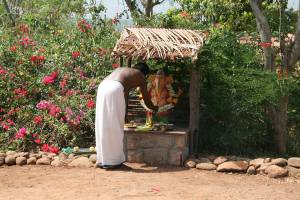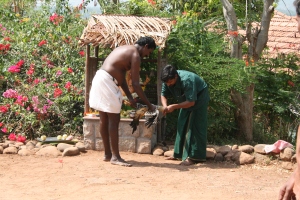Ganesh is one of the most popular, if not the most popular, god worshipe d by Hindus here in Tamil Nadu. At Lakeside we have provided a shrine to Ganesh, and this is frequently used by drivers, Indian guests and, of course, our staff.
d by Hindus here in Tamil Nadu. At Lakeside we have provided a shrine to Ganesh, and this is frequently used by drivers, Indian guests and, of course, our staff.
The statue was made by a local potter and consecrated by a local priest. The puja (worship) for the consecration was attended by ourselves, our staff, and some of the guests who were staying at Lakeside as part of one of our tours.
 At the start of the ceremony for the consecration of the statue incense sticks were lit and waved in front of Ganesh before being placed on the altar. A bell was rung which signified the presence of the god then a cockerel was sacrificed (later to be taken and eaten by the priest). It was killed quickly by cutting its throat which is the same way that chickens are killed here for food. Some of the blood from the cockerel was placed on each corner of the shrine.
At the start of the ceremony for the consecration of the statue incense sticks were lit and waved in front of Ganesh before being placed on the altar. A bell was rung which signified the presence of the god then a cockerel was sacrificed (later to be taken and eaten by the priest). It was killed quickly by cutting its throat which is the same way that chickens are killed here for food. Some of the blood from the cockerel was placed on each corner of the shrine.
 A coconut was broken and the milk sprinkled onto the statue by the priest, Pete and myself. Then everyone present had a tilaka (spot made with yellow and red paste) put on their forehead and were given coconut, banana and sweet pongal rice to eat from a banana leaf.
A coconut was broken and the milk sprinkled onto the statue by the priest, Pete and myself. Then everyone present had a tilaka (spot made with yellow and red paste) put on their forehead and were given coconut, banana and sweet pongal rice to eat from a banana leaf.
So who is Ganesh and why is he so special?
 In Hindu mythology Ganesh is the son of the gods Shiva and Parvati with a human body (symbolising Maya, or the earthly existence of humans) and an elephant head (symbolising the Atma or soul). The elephants head shows wisdom and the trunk symbolises the sacred sound Om which is used during meditation and is believed to be the sound heard at the creation of the universe and so symbolises cosmic reality.
In Hindu mythology Ganesh is the son of the gods Shiva and Parvati with a human body (symbolising Maya, or the earthly existence of humans) and an elephant head (symbolising the Atma or soul). The elephants head shows wisdom and the trunk symbolises the sacred sound Om which is used during meditation and is believed to be the sound heard at the creation of the universe and so symbolises cosmic reality.
 Ganesh has four hands: in the upper right he carries a goad to help him encourage people forward on the eternal path of life and to remove obstacles from their way; his upper left hand holds a noose to capture and remove all difficulties from the path. His lower right hand holds his broken tusk which he used as a pen to write the Mahabharata, and his final hand holds a rosary to remind worshipers that they should be continually pursuing knowledge. He holds a laddoo (sweet) in his trunk to remind people to seek the sweetness of the Atma.
Ganesh has four hands: in the upper right he carries a goad to help him encourage people forward on the eternal path of life and to remove obstacles from their way; his upper left hand holds a noose to capture and remove all difficulties from the path. His lower right hand holds his broken tusk which he used as a pen to write the Mahabharata, and his final hand holds a rosary to remind worshipers that they should be continually pursuing knowledge. He holds a laddoo (sweet) in his trunk to remind people to seek the sweetness of the Atma.
The elephant ears show that Ganesh is always willing to listen to any petition, the snake around his waist represents energy in all its forms.
Ganesh is the bringer of success and the destroyer of evil and obstacles as well as being worshipped as the god of wisdom, education, knowledge and wealth. He is seen riding a mouse which shows his humility.
There are almost as many views of the Hindu belief in a pantheon of gods as there are gods themselves. Some westerners find it hard to reconcile a religion with so many different deities, all with human characteristics, with their own monotheistic faiths and so discount Hinduism as primitive idol worship. However, you can talk with many Hindus who explain their belief in a transcendent power beyond the universe called Brahman. Brahman is so overwhelmingly powerful that it is impossible for mere humans to understand him/it and so all of the Hindu gods are just aspects of this Brahman to help us understand. A Hindu can worship a particular god when they wish to approach a particular aspect of the supreme being – maybe seeing Brahman as a father figure, or a mother, or a king.
One could argue that this is similar to monotheistic faiths who describe their God in many different ways such as Compassionate, King etc – both aspects of one god but helping us to understand him more deeply. It could also be argued that the Christian Trinity has similarities to the Hindu belief as it is a belief in one true god but showing his different characteristics – creator, saviour, guide and comforter.
Whatever your view of Hinduism and its many gods I know that, for me personally, living here amongst the people of Tamil Nadu has been a real eye-opener.
